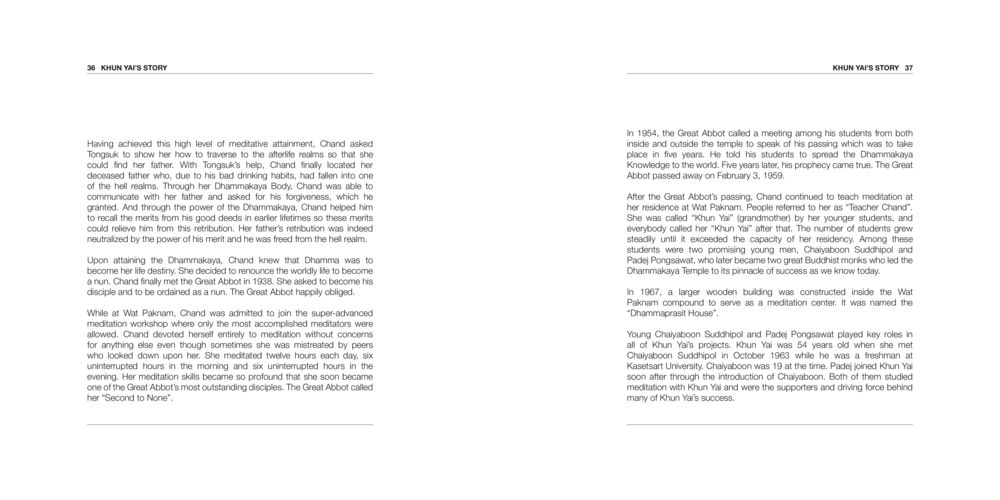Chand's Journey to Enlightenment and Teaching Dhamma : หน้า 19/135
Khun Yai’s Teachings : หน้า 19/135 This narrative follows Chand's spiritual journey, her reunion with her father, and her commitment to teaching Dhamma and meditation.
3 ครั้ง

สรุปเนื้อหา
Chand achieved a high level of meditative attainment and sought to find her father in the afterlife. With Tongsuk's help, she communicated with her father in a hell realm, assisting him in recalling his good deeds to alleviate his suffering. Realizing her calling in Dhamma, she became a nun and studied under the Great Abbot, devoting herself to meditation. After his passing, she continued teaching and became known as Teacher Chand, nurturing future monks and establishing a meditation center. Her legacy in the Dhamma continues through numerous students and disciples.
หัวข้อประเด็น
-Chand's spiritual journey
-reunion with her father
-commitment to meditation and Dhamma
-Great Abbot's influence
-establishment of meditation center
ข้อความต้นฉบับในหน้า
Having achieved this high level of meditative attainment, Chand asked Tongsuk to show her how to traverse to the afterlife realms so that she could find her father. With Tongsuk's help, Chand finally located her deceased father who, due to his bad drinking habits, had fallen into one of the hell realms. Through her Dhammakaya Body, Chand was able to communicate with her father and asked for his forgiveness, which he granted. And through her power of the Dhammakaya, Chand helped him to recall the merits from his good deeds in earlier lifetimes so these merits could relieve him from this retribution. Her father's retribution was indeed neutralized by the power of his merit and he was freed from the hell realm.
Upon attaining the Dhammakaya, Chand knew that Dhamma was to become her life destiny. She decided toreneunce the worldly life to become a nun. Chand finally met the Great Abbot in 1938. She asked to become his disciple and to be ordained as a nun. The Great Abbot happily obliged.
While at Wat Paknam, Chand was admitted to join the super-advanced meditation workshop where only the most accomplished meditators were allowed. Chand devoted herself entirely to meditation without concerns for anything else even though sometimes she was mistreated by peers who looked down upon her. She meditated twelve hours a day, six uninterrupted hours in the morning and six uninterrupted hours in the evening. Her meditation skills became so profound that she soon became one of the Great Abbot's most outstanding disciples. The Great Abbot called her "Second to None".
In 1954, the Great Abbot called a meeting among his students from both inside and outside the temple to speak of his passing which was to take place in five years. He told his students to spread the Dhamma Knowledge to the world. Five years later, his prophecy came true. The Great Abbot passed away on February 3, 1959.
After the Great Abbot's passing, Chand continued to teach meditation at her residence at Wat Paknam. People referred to her as "Teacher Chand". She was called "Khun Yai" (grandmother) by her young students, and everybody called her "Khun Yai" after that. The number of students grew steadily until it exceeded the capacity of her residence. Among these students were two promising young men, Chaiyaboon Sudyappa and Padej Pongsawat, who later became two great Buddhist monks who led the Dhammayaya Temple to its pinnacle of success as a new world today.
In 1967, a larger wooden building was constructed inside the Wat Paknam compound to serve as a meditation center. It was named the "Dhammaprasti House".
Young Chaiyaboon Sudyappa and Padej Pongsawat played key roles in all of Khun Yai's projects. Khun Yai was 54 years old when she met Chaiyaboon Sudyappa in October 1963 while he was a freshman at Kasetsart University. Chaiyaboon was 19 at the time. Padej joined Khun Yai soon after through the introduction of Chaiyaboon. Both of them studied meditation with Khun Yai and were the supporters and driving force behind many of Khun Yai's successes.
หน้าหนังสือทั้งหมด
หนังสือที่เกี่ยวข้อง
Load More







































































































































